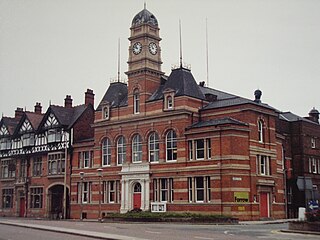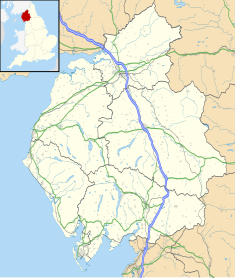
Wetherby Town Hall is a community building in Wetherby, West Yorkshire, England. The town hall no longer plays a major civic function but provides an office which is used by Wetherby Town Council and facilities for local groups and events. It is a Grade II listed building.

The Tallinn Town Hall is a building in the Old Town (Vanalinn) of Tallinn (Reval), Estonia, next to the Town Hall Square. The building is located in the south side of the medieval market square and is 36.8 metres (121 ft) long. The west wall is 14.5 metres (48 ft) in length, and the east is 15.2 metres (50 ft). It is a two-storey building with a spacious basement. It is the oldest town hall in the whole Baltic Sea region and Scandinavia.

St Martin's Church is in Front Street, Brampton, Cumbria, England. It is an active Anglican parish church in the deanery of Brampton, the archdeaconry of Carlisle and the diocese of Carlisle. It is recorded in the National Heritage List for England as a designated Grade I listed building and is the only church designed by the Pre-Raphaelite architect Philip Webb. The architectural historian Nikolaus Pevsner described it as "a very remarkable building".

The Shire Hall is a municipal building in Fore Street, Hertford, the county town of Hertfordshire, England. The building, which currently serves as a Magistrates' Court, is a Grade I listed building.

The County Hall, also known as County Offices, is a building in Stricklandgate, Kendal, England. The structure, which was the headquarters of Westmorland County Council from 1939 to 1974, is a Grade II listed building.

Acton Town Hall is a municipal building in High Street, Acton, London, England. It is a Grade II listed building.

The Old Town Hall is a municipal building in West Street, Gateshead, England. It is a Grade II listed building.

Carlisle Civic Centre is a municipal building in the Rickergate, Carlisle, England. It was the headquarters of Carlisle City Council.

Banbury Town Hall is a municipal facility in the High Street in Banbury, Oxfordshire, England. The town hall, which was the headquarters of Banbury Borough Council from its completion in 1854 until 1930, is a Grade II listed building. It now serves as the headquarters of Banbury Town Council.

Chorley Town Hall is a municipal building in Market Street in Chorley, Lancashire, England.

The Old Town Hall and Market Hall is a municipal complex in West Row in Darlington, County Durham, England. The old town hall was the headquarters of Darlington Borough Council until it moved to the new town hall in Feethams in 1970. The complex consists of three separate buildings, all of which are Grade II listed: the old town hall, the market hall and the clock tower.

Hereford Town Hall is a municipal building in St Owen's Street, Hereford, Herefordshire, England. The building is a Grade II* listed building.

The Old Town Hall is a municipal building in the High Street, Reigate, Surrey, England. It is a Grade II* listed building.

Eccles Town Hall is a municipal building in Church Street, Eccles, Greater Manchester, England. The town hall was the headquarters of Eccles Borough Council until the council was abolished in 1974.

Congleton Town Hall is a municipal building in the High Street, Congleton, Cheshire, England. The town hall, which is the meeting place of Congleton Town Council, is a grade II* listed building.

Settle Town Hall is a municipal building in Cheapside in Settle, North Yorkshire, England. The structure, which was the meeting place of Settle Rural District Council, is a Grade II listed building.

Morpeth Town Hall is a municipal building in the Market Place, Morpeth, Northumberland, England. The structure, which was the meeting place of Morpeth Borough Council, is a Grade II listed building.

The Old Town Hall is a municipal building in The High Street in Steyning, West Sussex, England. The building, which was used as a courthouse and a public events venue, is a Grade II listed building.

The Moot Hall is a municipal building in The Market Place in Brampton, Cumbria, England. The building, which is used as a local tourist information office and as a meeting place for Brampton Parish Council, is a Grade II* listed building.

The Old Town Hall is a municipal building in The Square, Broughton-in-Furness, a town in Cumbria, England. The building, which currently accommodates a tourist information centre and a shop, is a Grade II listed building.





















